Il raggiungimento di un ricamo impeccabile può sembrare complicato, Ma alcune semplici regolazioni possono fare la differenza. Concentrandosi su fattori specifici, Puoi migliorare la qualità dei ricami e produrre risultati a livello professionale.
In questo articolo, Esploreremo i fattori chiave che contribuiscono a migliori ricami, Dalle adeguate scelte materiali alla padronanza delle impostazioni della macchina, Garantire che i tuoi progetti vadano magnificamente ogni volta.

12 Fattori importanti che migliorano la qualità del ricamo
Fattori per migliorare la qualità del ricamo
Migliorare la qualità di ricamo a macchina comporta l'attenzione su diversi fattori chiave che possono influenzare notevolmente il risultato finale.
- Nitidezza dell'ago
- Qualità del filo
- Tensione del filo superiore
- Tensione del filo inferiore
- Spessore di carta di supporto
- Qualità della macchina
- Tensione inquadratura
- Aderenza alle istruzioni
- Qualità del tessuto
- Uso della tecnologia avanzata
- Dimensioni del tetto adeguate
- Tecnica di rimozione dello stabilizzatore
Adesso, let’;S Dai un'occhiata a come ognuno di questi fattori aiuta a migliorare la qualità del tuo ricamo.
1. Nitidezza dell'ago
Un ago affilato è cruciale per cuciture pulite e precise, Ed è uno dei fattori chiave come migliorare la qualità del ricamo a macchina. Gli aghi opachi possono causare punti sfilacciati e irregolari, conducendo a una scarsa finitura. Gli aghi che cambiano regolarmente in base al tipo di tessuto utilizzato garantiscono prestazioni ottimali.
Anche l'uso della dimensione dell'ago corretta per la combinazione di filo e tessuto è importante. Per esempio, È necessario un ago più grande per fili e tessuti più spessi, mentre un ago più piccolo è adatto per materiali più fini.
2. Qualità del filo
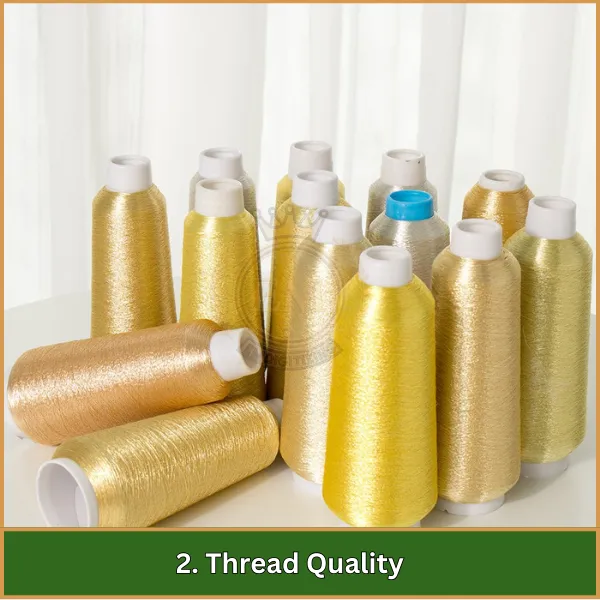
I fili di alta qualità sono essenziali per la durata e l'aspetto. Dovrebbero essere forti, Colorfast, e adatto al tessuto specifico. I fili di scarsa qualità possono rompersi facilmente e potrebbero non trattenere il loro colore nel tempo, influenzando l'aspetto generale del ricamo.
L'uso del tipo di filo appropriato per il tessuto è fondamentale per migliorare la qualità del ricamo. Ad esempio, I fili di poliestere sono adatti per la maggior parte dei tessuti, Mentre i fili di rayon forniscono una finitura brillante e vengono spesso utilizzati per materiali delicati.
3. Tensione del filo superiore
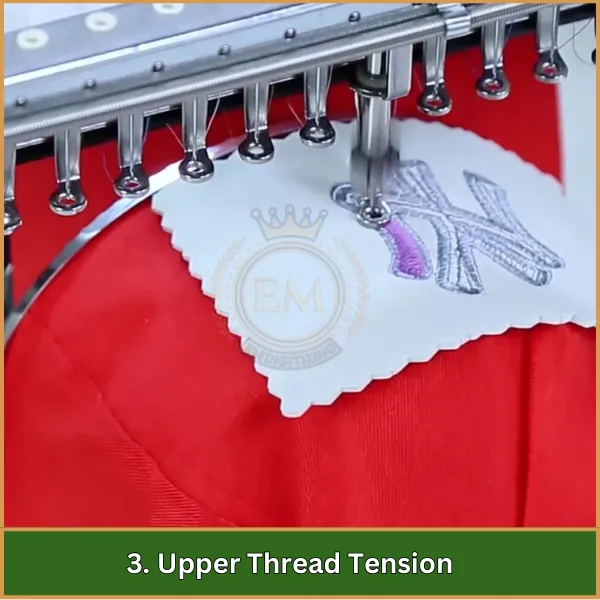
La tensione del filo superiore corretta è vitale per le cuciture bilanciate. Se la tensione è troppo forte, Il thread può rompere; if it’;è troppo sciolto, I punti possono apparire sciatti. La regolazione della tensione in base al tessuto e al tipo di filo aiuta a ottenere una finitura liscia.
La tensione dovrebbe essere abbastanza stretta da prevenire i loop sul lato inferiore del tessuto, consentendo comunque al filo di muoversi liberamente attraverso l'ago.
4. Tensione del filo inferiore
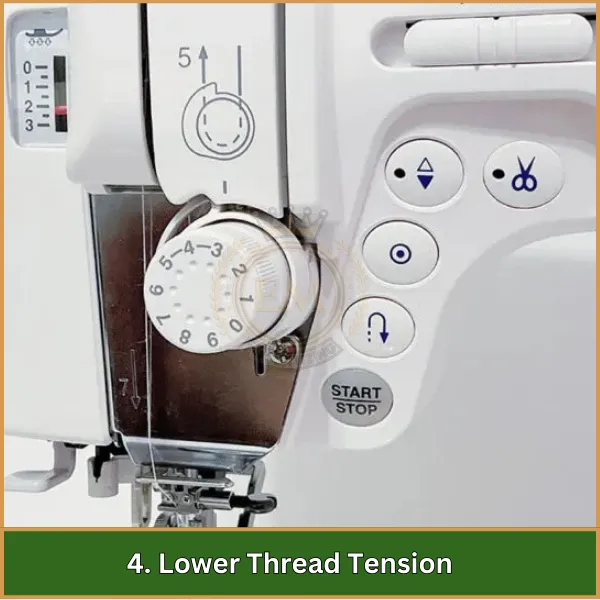
Simile alla tensione superiore, La tensione del filo inferiore deve essere impostata correttamente per garantire anche cuciture. Uno squilibrio può portare a problemi come il raggruppamento del filo o i punti sciolti sulla parte inferiore del tessuto.
Fine runing entrambe le tensioni è la chiave per migliorare la qualità dei ricami. La tensione della filettatura inferiore deve essere leggermente più stretta della tensione del filettatura superiore per mantenere una formazione di punti coerente.
5. Spessore di carta di supporto
Il materiale di supporto fornisce supporto al tessuto durante il ricamo. La scelta del giusto spessore impedisce la distorsione e garantisce che i punti mantengano la loro forma. Un supporto troppo sottile può portare a arricciare, mentre un supporto troppo spesso può essere visibile attraverso il tessuto.
Il tipo di materiale di supporto dovrebbe essere considerato, come alcuni sono più adatti per tessuti specifici. Per esempio, Il supporto tagliato è l'ideale per i tessuti a maglia, Mentre il supporto per lacrime funziona bene per i materiali tessuti.
6. Qualità della macchina
La qualità della macchina da ricamo svolge un ruolo significativo nel prodotto finale. Le macchine di fascia alta offrono una migliore precisione, più funzionalità, e migliore qualità del punto.
Investire in una macchina affidabile può migliorare l’esperienza di ricamo complessiva. Manutenzione regolare, come pulire e oliare la macchina, aiuta a garantire prestazioni ottimali e ne prolunga la durata.
7. Tensione inquadratura
Inquadrare correttamente il tessuto garantisce che rimanga teso durante il processo di ricamo. Il tessuto allentato può causare cuciture irregolari e distorsioni. Usare il telaio giusto e assicurarsi che il tessuto sia tenuto saldamente può prevenire questi problemi.
Il tessuto deve essere teso abbastanza da evitare cedimenti, ma non così stretto da distorcere il disegno o danneggiare il materiale.
8. Aderenza alle istruzioni
Following the manufacturer’;Le istruzioni sia per la macchina che per i materiali sono fondamentali. Ciò include le impostazioni per la tensione, velocità, e tipo di ago e filo. Aderente a queste linee guida aiuta a evitare insidie comuni che possono compromettere la qualità. Sperimentare con impostazioni e tecniche diverse può anche aiutare a migliorare le capacità di ricamo e produrre risultati migliori.
9. Qualità del tessuto
Il tipo e la qualità del tessuto migliorano significativamente la qualità del ricamo. I tessuti che sono troppo elastici o troppo spessi possono causare complicazioni. Scegliere il tessuto giusto che completa il design e il tipo di filo è essenziale per raggiungere un look lucido. Prenutere il tessuto per rimuovere qualsiasi dimensionamento o finitura può anche aiutare a migliorare la qualità del punto e prevenire il restringimento dopo il ricamo.
10. Uso della tecnologia avanzata
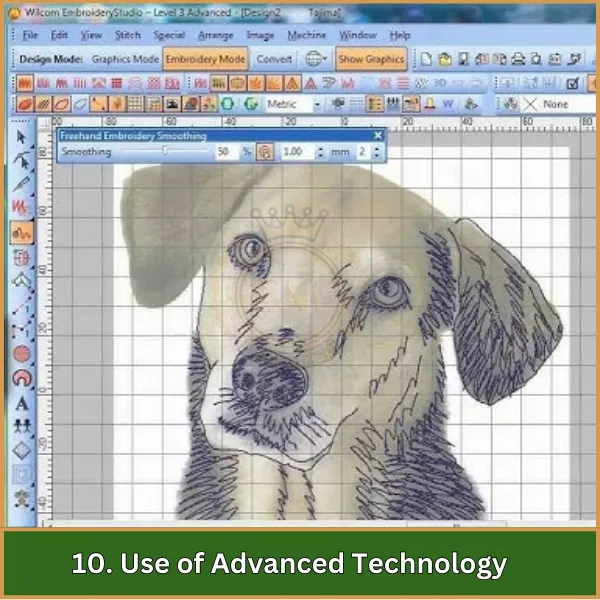
Incorporare tecnologie come software di digitalizzazione e le macchine automatizzate possono migliorare come migliorare la qualità dell'immagine dei ricami a macchina. Le funzionalità avanzate consentono design più intricati e cuciture precise. Rimanere aggiornati con la tecnologia più recente può migliorare l’efficienza e la qualità dell’output.
Il software di digitalizzazione consente la creazione di disegni complessi che possono essere facilmente trasferiti alla macchina da ricamo, mentre le macchine automatizzate garantiscono qualità e velocità del punto costanti.
11. Dimensioni del tetto adeguate
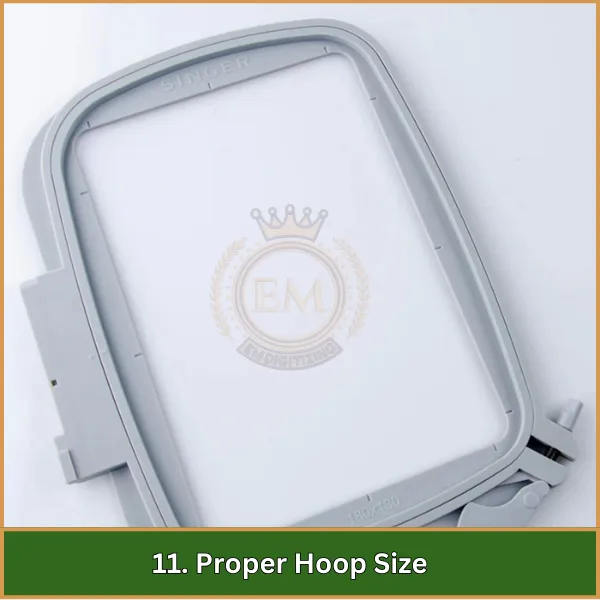
È fondamentale utilizzare la dimensione del telaio corretta per il tessuto e il disegno. Un telaio troppo grande potrebbe causare lo spostamento del tessuto durante il processo di ricamo, portando a disallineamento o distorsione nel design. Un telaio adeguatamente montato garantisce che il tessuto rimanga saldamente in posizione, con conseguente cucitura più accurata e coerente.
12. Tecnica di rimozione dello stabilizzatore
Il modo in cui rimuovi lo stabilizzatore dopo il ricamo può influenzare l'aspetto finale del disegno. Una rimozione impropria potrebbe causare l'allungamento o la distorsione del tessuto. It’;s essential to follow the manufacturer’;s istruzioni per rimuovere lo stabilizzatore, sia che si tratti di tagliarlo, lacrimazione, o dissolversi: per mantenere l'integrità di entrambi tessuto per il ricamo.
Incartare
Per migliorare davvero la qualità del ricamo, avere un design ben digitalizzato è essenziale. Anche con le migliori tecniche e attrezzature, una scarsa digitalizzazione può rallentare i tuoi progetti.
Prima di concludere, se hai bisogno di servizi di digitalizzazione, sentitevi liberi di contattarci. Noi offriamo servizi di digitalizzazione a prezzi accessibili con risultati di qualità garantiti. We’;stai offrendo 50% verso nuovi clienti, so grab this amazing deal before it’;E' troppo tardi!
Grazie per aver letto questo articolo. Se ti è piaciuto, per favore condividilo. You’;sei sulla buona strada per diventare un professionista del ricamo!
Domande frequenti
Digitalizzazione nel ricamo è il processo di conversione del disegno in un file digitale leggibile da una macchina da ricamo. Una buona digitalizzazione garantisce fluidità, cuciture accurate, che migliora notevolmente la qualità del ricamo finale.
Il filo di alta qualità riduce le possibilità di rottura e sfilacciamento, portando a un ricamo più liscio e vibrante. Una scarsa qualità del filo può provocare cuciture irregolari e una finitura meno professionale.
Uno stabilizzatore mantiene fermo il tessuto durante il ricamo, impedendogli di allungarsi o spostarsi. Ciò garantisce la pulizia, precise stitching and helps maintain the design’;s forma e qualità.
Disegni complessi con dettagli intricati possono essere difficili da ricamare e potrebbero richiedere tecniche più avanzate e una migliore digitalizzazione. I progetti più semplici sono generalmente più facili da eseguire e hanno una qualità superiore.
